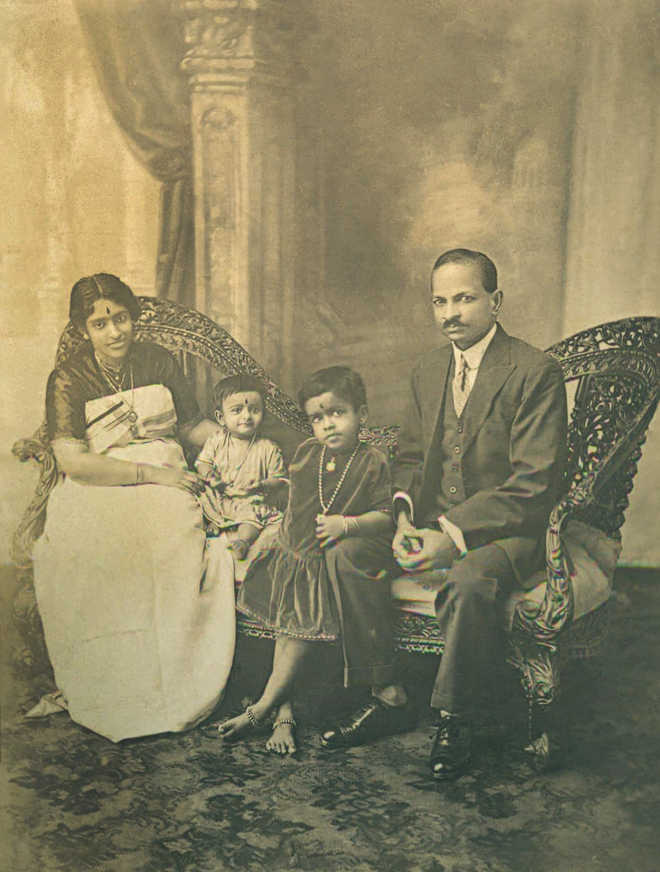
Sethu Lakshmi Bayi with her consort and royal children in the 1920s
Ajith Pillai
Meticulous research must merge with engaging writing to make the re-creation of the past worthwhile for the reader. Unfortunately, such an amalgam is an exception since those who probe into times long gone by may excel in scholarship but all too often stumble when they wield the pen. This renders history a rather dull and insipid exercise as far as the reader is concerned.
Luckily, this union between the cumbersome collation of historical facts and distilling these into a compelling narrative works in Manu S. Pillai’s The Ivory Throne: Chronicles of the House of Travancore. Indeed, it would not be an exaggeration to credit it as a particularly fascinating account spanning over three centuries of a rich and many-layered history of the royal house of Kerala.
It is a history that has so far remained obscured with available writings drowned in hagiography that have faithfully resisted probing the lives, the prejudices, the controversies, the follies, failings and the palace intrigues that impinged on the lives of the kings and queens who dominated the royal landscape.
That the House of Travancore has been ignored by historians and researchers is rather curious given that there is so much interest in Kerala. The state’s now defunct matrilineal society, its communism, its high literacy and its empowerment of women often come up for discussion. And yet most of us know little about its rich history beyond the paintings of Raja Ravi Varma.
But what of the past from which modern Kerala evolved? Pillai’s book provides valuable insight because The Ivory Throne is also a sociological study — perhaps the first of its kind at least in English—of pre-Independent Travancore which became Kerala, as we now know it, in October 1956.
The narrative is focussed on the rise and fall of Sethu Lakshmi Bayi, often described as the last and forgotten queen of the House of Travancore or the ‘Senior Rani’. Lakshmi Bayi was Raja Ravi Varma’s granddaughter and she and her cousin, Sethu Parvathi Bayi (the ‘Junior Rani’), were uprooted from their family home in Mavelikkara and adopted into the royal family in 1900. This was a customary practice since the 14th century in the House of Travancore, which had a severe paucity of girls to continue the matrilineal lineage.
The cousins, who belonged to the Kolathiri clan with royal linkages, were thus catapulted to Trivandrum to the apex royal House and groomed to become royals. But their adoption was followed by the ‘grim epidemic of death in the royal family.’ Fate claimed the lives of four original royal male members and Lakshmi Bayi was proclaimed the Senior Rani at the age of five.
It was her male progeny who would have been the future king. But that was not to be because of a series of miscarriages. Thus it was her nephew, Chithira Thirunal, son of her cousin who became the heir to the throne and Lakshmi Bayi had to be content to play regent from 1924-1931 while the prince in waiting grew up.
The tale of the two cousins and their bitter fight for supremacy, the palace intrigues, their interactions with agents of the British Crown and the darker side of human nature are all brought out in the book. The Junior Rani who saw her cousin dominate during the Regent years claimed her place in the limelight once her son ascended the throne. From then on began the sidelining of Lakshmi Bayi. She died in 1985 in Bangalore, a forlorn, lonely and forgotten figure.
Woven into the narrative is the history of Travancore since the days of Martanda Varma. It also examines the lives of the frustrated young princesses as they grew up in ‘splendid isolation’ in the palace cramped by rigorous rules and traditions. The book throws up facts unknown to many — Raja Ravi Varma, for example, though of royal lineage, was not a ‘Raja.’ It was a title bestowed on him after he achieved artistic fame. It is also not known that he had a troubled marital life and that his neglected and distraught wife, Kochupanki, died at the age of thirty six of alcoholism.
Nuggets like these embellish the book which took the author six years to research. It was an effort which took him to the Kerala State Archives, the National Archives in Delhi, British Archives in London and Lakshmi Bayi’s personal papers in Bangalore. He also interacted with several people connected with the royal family.
I confess I hadn’t so much as heard about Manu S. Pillai when I picked up a copy of The Ivory Throne at Bahrisons in Delhi. I instinctively felt that the book looked promising and worthy of a read. I am happy to report that my intuition was right.



























